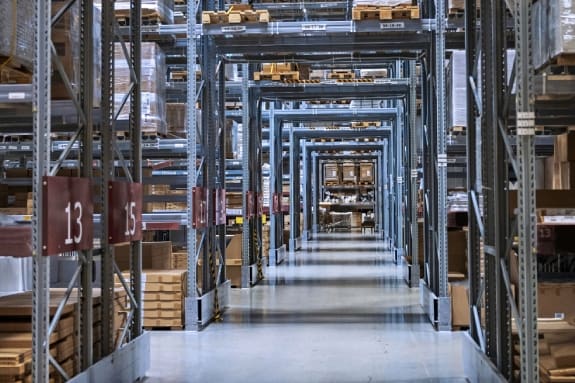Years after the worst disruptions of the COVID-19 pandemic, supply chains are still under pressure. Global conflicts, rising costs, and shifting customer demands have forced procurement teams to rethink approaches, leading many to question: Should we source materials locally or globally? Both approaches involve trade-offs in costs, efficiency, risk, and environmental impact. Weighing the pros and cons of each can help provide guidance for making smart, flexible sourcing decisions in a world where certainty is still in short supply.
What Is Global Sourcing?
Global sourcing is the practice of purchasing goods or services from suppliers located beyond the borders of a company’s home country. Businesses tend to tap into international supply chains in search of lower costs, specialized expertise, and a broader selection of suppliers.
Global sourcing is common in a variety of industries, including manufacturing, mass retail, and consumer electronics. For example, Apple, which is based in California, sources iPhone components from countries like Taiwan and South Korea. Automakers, such as Ford and Toyota, build vehicles in the US using globally sourced parts. American retailers, such as Walmart and Target, also rely heavily on globally sourced apparel, electronics, and home goods.
What Is Local Sourcing?
Local sourcing is the practice of purchasing goods or services from suppliers geographically located near a company’s operations, typically within the same country or region. Businesses often turn to local suppliers to reduce transportation costs, shorten lead times, and avoid international risks and disruptions.
This approach is common among industries where speed and regional control are vital, including food service, fashion, and some areas of manufacturing. For example, restaurants often source produce from nearby farms to guarantee freshness, while apparel brands might partner with regional textile mills to streamline production. In recent years, rising shipping costs and ongoing global supply chain disruptions have prompted many companies to prioritize sourcing closer to home.
Key Takeaways
- In 2025, overall sourcing optimism was found to be at its lowest level in four years.
- Global sourcing gives companies access to niche technical capabilities that may not be available domestically.
- One of the main drawbacks of local sourcing is higher production costs.
- More companies are diversifying their supplier networks to reduce dependence on any single source.
- Regularly monitoring sourcing strategies, with the help of software, facilitates timely, informed adjustments.
Advantages of Global Sourcing
You might expect that recent supply chain disruptions and ongoing geopolitical tensions would push companies to favor local sourcing. Yet, businesses are not retreating from global trade. In fact, a QIMA survey of more than 650 companies found that despite tariff concerns, two-thirds plan to maintain or expand business with Chinese suppliers in 2025.
Many businesses continue to rely on global sourcing because they find the advantages, such as lower costs and broader supplier access, often outweigh the risks. Here’s a closer look at five main advantages of global sourcing:
- Cost savings: Raw materials, labor, and utilities often cost significantly less in places like Vietnam, India, or Mexico than in the US or Europe. With inflation putting pressure on margins, many companies are turning to global sourcing to cut expenses and stay competitive. Labor costs and availability were the top reasons companies considered relocating their supply chains, according to a recent PwC survey.
- Scalability: Instead of relying on a single local supplier that may be limited by capacity, geography, or labor shortages, businesses sourcing globally can shift orders to regions with available resources and faster turnaround times. So, if demand spikes in North America, a company with suppliers in Asia, Europe, and Latin America can allocate production across those regions. Global partners often have larger production capacities, allowing companies to scale incrementally without incurring the high cost of expanding their own domestic operations.
- Access to new markets: Global supply chains give companies access to a more diverse network of suppliers, labor, and production facilities worldwide. Beyond purveying materials, international vendors can serve as strategic partners that offer insights into local consumer preferences, regulations, and pricing that help businesses enter new markets more smoothly.
- Supplier specialization: Global sourcing gives companies access to niche technical capabilities that may be unavailable—or too expensive—at home. Certain regions have cultivated deep expertise in specific industries: Germany and Japan in precision engineering, South Korea and Taiwan in semiconductors, and India in large-scale IT and software services. Sourcing from these regions allows companies to tap into innovative technologies, helping them build better products.
- Supply chain diversification: Relying on a single local supplier can leave a company’s entire supply vulnerable to upheaval from weather, labor shortages, or other disruptions. Global sourcing allows procurement teams to build a more resilient supply base across regions, reducing dependence on any one supplier or region. In a 2024 Maersk survey, decision-makers said supply chain diversification is relevant to their company’s logistics, ranking it among the top three industry trends.
Disadvantages of Global Sourcing
Though global sourcing offers many advantages, it also introduces a range of risks. One-third of companies worldwide expect supply chain disruptions to worsen in 2025, and overall sourcing optimism is at its lowest in four years, according to the QIMA survey. Keeping these statistics in mind, companies should weigh the benefits of global sourcing against the following potential drawbacks:
- Global supply chain disruptions: A range of factors—including geopolitical tensions, extreme weather events, regulatory shifts, and infrastructure breakdowns—can destabilize international supply routes. These supply chain disruptions render cross-border flows unpredictable, often resulting in longer lead times, delays, and increased costs as companies scramble to secure alternative suppliers.
- Logistics complexity: Thomson Reuters’ 2024 report on global trade named “complexity” the defining feature of supply chain management in 2025. Evolving trade regulations, political tensions, and natural disasters can paralyze international logistics, where even a minor delay in one region can ripple through a network, precipitating missed deadlines and lost revenue.
- Security risks: Global sourcing can expose digital and physical security vulnerabilities, particularly when the business is working with suppliers in regions with weaker regulatory oversight or limited cybersecurity infrastructure. Expanding operations across borders may inadvertently increase the risk of data breaches, IP theft, and unauthorized access to sensitive information—issues that can be costly and damage a company’s reputation.
- Hidden costs: While global sourcing can offer cost savings, hidden expenses can chip away at those gains. Tariffs, fluctuating exchange rates, regulatory compliance-related expenses, and additional quality control can quickly add up. Managing distant suppliers also increases administrative overhead and raises the specter of costly miscommunications.
- Cultural misunderstandings: Cultural differences, language barriers, and conflicting business practices can complicate negotiations and daily operations. These challenges can lead to misaligned goals, production delays, quality issues, or strained supplier relationships, all of which can thwart a company’s ability to meet customer demand.
Advantages of Local Sourcing
With global supply chains so vulnerable to disruptions and delays, many companies are turning to local suppliers to increase operational agility and reduce risk. A recent Capgemini survey of more than 300 consumer product and retail organizations found that 70% are regionalizing and localizing their supplier bases. Meanwhile, a 2025 survey shows that 85% of American automotive manufacturers plan to do more business with North American suppliers through 2026, and 41% plan to reshore manufacturing operations, often with the goal of improving supply chain resilience and reducing transportation costs.
Local sourcing offers companies the following strategic and operational advantages:
- Decreases logistics costs: One of the largest financial benefits of local sourcing is the reduction in transportation expenses. Working with nearby suppliers eliminates international freight charges, customs duties, tariffs, and port fees, while also simplifying logistics coordination and reducing warehousing costs through shorter delivery and storage timelines.
- Improves transit times: Local sourcing shrinks delivery windows from weeks to days—or even hours—allowing businesses to replenish inventory quickly and cut down on safety stock. A bakery sourcing flour locally, for example, might get next-day delivery, whereas imports could be subjected to weeks of delays. Faster transit is especially crucial in sectors like food and beverage, where just-in-time delivery helps guarantee fresh products and prevent spoilage.
- Supports local economies: Buying from local suppliers directly supports regional economic development. A 2024 study by Supplier.io found that every dollar paid to a local supplier generated an additional $1.80 of economic activity, supporting more than 1.4 million jobs, $105 billion in income, and $37 billion in tax revenue. Local salaries also tend to stay in the community, recirculating through spending on food, clothing, and services.
- Reduces environmental impacts: Local sourcing can support supply chain sustainability by decreasing transportation distance and emissions. For example, trucking materials 25 miles generates significantly less pollution than flying them 10,000 miles. Companies like Patagonia have reshored portions of their supply chain to diminish their environmental impact—an action likely to appeal to eco-conscious consumers.
- Increases responsiveness: Local sourcing allows companies to react promptly to disruptions, changing customer needs, and quality control issues. Having nearby suppliers facilitates faster communication, easier collaboration, and rapid fixes. For example, a manufacturer might get a replacement part within a day, instead of waiting days or weeks to receive an international shipment. This kind of agility is particularly important for fast-moving industries, such as fashion, consumer electronics, and food service, because the ability to make last-minute changes or quickly launch new products can spell the difference between making a sale or missing an opportunity.
Disadvantages of Local Sourcing
Local sourcing offers clear advantages for many companies, but it’s not without its drawbacks—especially as businesses navigate inflation-related cost increases, labor shortages, and regional disruptions. Businesses should be aware of the following challenges if they rely primarily on local suppliers:
- Increased production costs: Local sourcing often comes with higher labor, regulatory, and raw material costs compared to using suppliers located in lower-cost regions. These added expenses can make it tough for companies to compete with rivals that source materials globally at lower prices, potentially putting market share at risk.
- Lack of expertise: In some cases, local suppliers may lack the specialized skills, technology, or capacity to meet a company’s needs. This can limit access to advanced materials or cutting-edge production methods, potentially forcing companies to compromise on quality—and thereby run the risk of failing to keep pace with customer expectations.
- Less supplier competition: In some regions, a limited pool of local suppliers can lead to higher prices or less favorable contract terms. Without strong competition, vendors may be less motivated to innovate or improve production methods, slowing product development and reducing a company’s ability to adapt to changing market demands.
- Regional disruptions: While local sourcing may be immune to global shocks, it still leaves companies vulnerable to natural disasters, labor strikes, political instability, or economic downturns. A local flood or wildfire, for instance, can shut down production facilities or disrupt transportation routes. Overreliance on too few local suppliers can amplify the risk of shortages if those vendors face operational or financial setbacks.
- Challenges meeting demand: Local suppliers may not be equipped to scale quickly during sudden demand spikes, resulting in stockouts and missed sales. To compensate, companies might have to hold more buffer stock, driving up storage costs. This can be especially difficult for industries facing seasonal or unpredictable demand patterns.
Trends in Supply Chain Sourcing
Several trends are reshaping the supply chain sourcing landscape, as procurement teams in increasingly volatile markets seek a balance between cost and resilience.
Companies are increasingly diversifying their supplier networks in response to ongoing disruptions arising from geopolitical tensions, trade wars, natural disasters, and economic pressures. The goal is straightforward: reduce overreliance on any one source or region, whether global or domestic. Apple, for example, has shifted some of its iPhone production from China to India and Vietnam to ease exposure to potential trade risks. In the textile industry, many companies are following a similar path, expanding their sourcing footprint from China to countries like Bangladesh and Vietnam with an eye toward cost efficiency and greater supply stability.
Similarly, “glocalization” strategies are taking hold as businesses blend the scale of global sourcing with the responsiveness of nearby markets. Nearly half of US businesses plan to increase nearshoring in 2025, with many firms shifting away from China in favor of Mexico to sidestep tariffs, according to a QIMA report.
Sustainability and ethical sourcing are rising in importance, moving from a “nice-to-have” attribute to a strategic “must.” Companies feel increasing pressure from consumers, investors, and regulators to source from suppliers that prioritize eco-friendly practices, reduce carbon emissions, and uphold fair labor standards. Thomson Reuters’ global trade report found that 81% of survey respondents considered environmental, social, and governance (ESG) criteria increasingly important in supplier selection. Businesses that embed sustainability into their sourcing can strengthen brand loyalty, meet regulatory expectations, and gain an edge over less forward-thinking competitors.
More businesses are relying on AI to make smarter, faster sourcing decisions. AI technology can help forecast demand, optimize supplier selection, and flag potential risks before they escalate. In fact, the Hackett Group’s 2025 Key Issues study notes that 89% of executives across business functions said their organizations are diving deep into generative AI—a marked leap from only 16% citing business transformation through GenAI as a high priority in 2024. Some organizations are already seeing up to 25% gains in productivity, quality, and customer experience, according to the same report. And nearly two-thirds of procurement executives say they expect AI to fundamentally reshape the way their teams operate in the next five years.
How to Choose the Right Sourcing Strategy
Selecting the appropriate sourcing strategy is an important decision that can significantly affect a company in many ways—altering costs, determining their resilience in the face of disruptions, and impacting their ability to produce quality products that meet customer demand. To carefully evaluate how and where to source goods, consider following this step-by-step guide:
- Define your business objectives: Are you focused on reducing costs, speeding up time to market, improving quality, or something else? Your sourcing strategy should align with your goals. A fast-scaling startup might prioritize affordability, while a luxury brand might care more about tight quality control.
- Evaluate your product or service requirements: The right approach often depends on what you’re selling. Highly specialized technical components might require global expertise, whereas perishable goods benefit from local partners that can deliver quickly.
- Consider global, local, or hybrid sourcing options: Ascertain what trade-offs may be needed in terms of cost, lead times, expertise, and complexity—a hybrid approach that mixes global and local sourcing might prove to be the solution that balances efficiency and resilience. Look beyond sticker price to determine the total cost of ownership, including shipping, import duties, inventory holding, compliance costs, and other “hidden” expenses.
- Assess your risk exposure: Use supply chain mapping tools to discern potential vulnerabilities, such as those caused by natural disasters, political instability, or regulatory changes. Diversifying your supplier base and creating contingency plans can help mitigate these risks and improve continuity.
- Factor in ESG and sustainability goals: Customers, investors, and even employees increasingly expect responsible sourcing. Ethical labor practices, low environmental impact, and strong ESG alignment may give one supplier an edge over another with similar capabilities.
- Continuously monitor and adjust your sourcing strategy: Whatever approach you choose, remember to track key performance indicators, such as on-time delivery, quality, costs, and ESG compliance. Seek anecdotal feedback within your organization to get a feel for whether supplier relationships are running smoothly or hitting snags. Choosing a supplier doesn’t mean you’re locked in for life; it’s always worth reevaluating your options to make sure your strategy continues to serve your goals.
Take Control of Your Supply Chain With NetSuite
Sourcing challenges are complex, especially for industries navigating long lead times, pricing volatility, and shifting regional regulations. Whether you’re working with global suppliers or local partners, maintaining visibility and control is essential. NetSuite’s Building Materials Manufacturing and Distribution ERP Software offers real-time insights into inventory levels, supplier performance, and demand trends, helping businesses make informed sourcing decisions and better manage costs. Its cloud-based platform supports procurement workflows and centralizes supply chain data, making it easier for companies to quickly adapt to changing market conditions—whether they’re sourcing locally, globally, or through a hybrid model.
Choosing between global and local sourcing isn’t easy, since each approach brings distinct advantages and challenges that affect costs, efficiency, resilience, and customer satisfaction. The “best” option will hinge on various factors, including logistics complexity, supply chain reliability, total cost, and alignment with the business’s broader goals. A thoughtful, flexible sourcing strategy—powered by data-driven technology—can help companies evaluate supplier performance, mitigate risk, and adapt to changing conditions. For many, the best path to thriving over the long term may lie in adopting a hybrid sourcing model that blends the global reach and specialization provided by international suppliers with the speed and agility offered by local partners.
Global vs. Local Sourcing FAQs
What are the potential risks of relying solely on local suppliers?
Relying solely on local suppliers can increase costs, as domestic production often comes with more expensive labor and materials than overseas alternatives offer. It can also expose businesses to regional disruptions, including natural disasters or labor shortages, that could lead to material shortages or production delays.
Is global sourcing the same as importing?
Global sourcing is not exactly the same as importing. Importing is the act of bringing goods into a country, while global sourcing is a broader strategy that involves finding and managing suppliers internationally to meet cost, quality, and capacity goals.
What is an example of a global supply chain?
Apple is a prime example of a company that relies on a global supply chain. For instance, the company designs its iPhone products in the US; sources components from several countries, including Japan, Taiwan, and South Korea; assembles them in a number of places, such as China; and ultimately distributes the phones globally.








